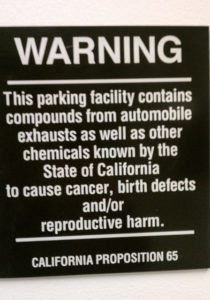Prop 65 warning labels highlighting the risk of cancer, reproductive harm, and birth defects are popping up on so many of the products I’m buying these days.
From hand gloves to chair cushions and spray cans to hardware tools, a variety of common household products are labeled with warnings stating that item may have substances known to the State of California to cause cancer or reproductive harm.
Pretty scary, huh?
Go shopping at just about any big box store and start looking at random items. Before long, you’ll probably find a product with this warning label:
California Proposition 65 Warning: This product may contain a chemical known to the State of California to cause cancer or birth defects or other reproductive harm.
Its ominous wording seems to suggest that even just touching the labeled product could lead you to an eventual cancer diagnosis or having children with serious physical or developmental delays or disabilities.
Is that really how dangerous these products are? And why are these State of California labels winding up on products in other states anyway? (I’ve bought many Prop 65 products in Florida and other states on the East Coast.)
I’ve been curious about this for years — when buying spray paint for furniture projects and gardening tools for the outdoors, for example. I once even bought a seat cushion that had the infamous Prop 65 warning.
The last straw for me was a piece of luggage I recently bought.
Seriously?! What about my luggage is potentially so dangerous that it deserves a Prop 65 birth defect and cancer warning in the first place?
California Prop 65 List Of Chemicals
Wondering how many Prop 65 chemicals there are? And which ones are on the list?
Some products, such as sprays and cleaners, come with a list of chemicals and other ingredients. Others, like my suitcase, don’t.
This makes it hard to know what you’re really buying — especially if the item you’ve bought has a Proposition 65 warning label on it.
There are more than 800 chemicals presently listed on the California Prop 65 list.
That’s too many to list here, but here’s a sneak peak at just a few of the chemicals on the Prop 65 list:
- Arsenic
- Asbestos
- Benzene
- Carbon monoxide
- Chinese-style salted fish
- Gasoline engine exhaust
- Lead
- Tetracycline
- Tobacco smoke
- Wood dust
Want to see what else is on the list of Prop 65 chemicals known for causing cancer or developmental, birth defects, and reproductive harm?
Here’s the entire list of Prop 65 chemicals.
Are Prop 65 Chemicals Really Dangerous?
Don’t at least a few items on that list above look eerily familiar? Asbestos, lead, tobacco… Proposition 65 means business.
But does that suggest every chemical on the Prop 65 list is equally dangerous?
The answer is that we don’t really know for sure. Scientists have plenty of evidence to know that certain chemicals cause cancer, development disabilities, and reproductive harm — as well as potentially other health maladies.
Take Wood Dust, For Example…
Is sanding down a wood craft project and accidentally getting some wood dust up into your nose just as dangerous as working on an old house and coming into contact with lead paint and asbestos tiling?
The danger is probably not as acute as inhaling asbestos fibers or getting lead paint chips in an open wound.
Yet, according to the 10th Report on Carcinogens by the National Toxicology Program, wood dust has been identified as a “known human carcinogen.” So it’s best to protect yourself from inhaling wood dust however possible.
But what scientists don’t know yet is whether or not certain wood types are more dangerous than others, the amount of cancer risk, or extent of other health hazards associated with wood dust.
In other words, it’s best to play it safe when cutting, sanding, or otherwise working with wood. For example, you should wear a face mask and safety goggles for protection.
Now, What About My Luggage?…
Could my luggage with a Prop 65 label really increase my chance of cancer or cause me reproductive harm?
Maybe, maybe not.
My specific piece of luggage has chemicals that may increase my risk of cancer or reproductive harm. But nobody really knows for sure if those chemicals will up my health risks.
By the way, another person asked a similar question on another health site. The respondent suggested the Prop 65 warning label was probably listed to help reduce the risk of lawsuits.
So is the Proposition 65 warning label a sign of real danger or is it to help save companies from lawsuits?
Some Background On The California Proposition 65 Warning Label
Proposition 65 passed in a 1986 California election — winning 63% of voter approval.
The law is also called The Safe Drinking Water & Toxic Enforcement Act 0f 1986, and its well-meaning purpose is to protect people from harmful water sources and other substances that may cause cancer, birth defects, and reproductive harm.
One way of enforcing the law is by requiring companies to place labels on products sold in California that contain (or may contain) chemicals that could pose certain health risks.
Proposition 65 is managed by the California Office of Environmental Health Hazard Assessment, which is part of the California Environmental Protection Agency.
Because all companies who sell affected products in California have to apply the Prop 65 label to those items, it’s become cheaper and easier for them to simply slap the warning on all items being sold anywhere.
This is good — because it helps all people, including Californians, become more aware of the hidden dangers in some of the products they buy.
If you live in or have visited California, you’ve probably even seen the signs on buildings, including parking garages — in which you’ll encounter car exhaust (an aforementioned carcinogen).
In legal terms, this is to warn the public they’re entering a building that may contain at least one of the known (or suspected) carcinogens or substances that lead to birth defects.
It could merely mean that certain cleaning products used in the building contain one of these chemicals. Or it could mean the building has lead paint and asbestos ceiling tiles.
How To Cope With Prop 65
When the Proposition 65 labels started appearing just about everywhere by the end of the 1980s, a public health scare flourished.
Some think the Prop 65 labels have desensitized the public, or have caused undue hype. If the Prop 65 warnings are everywhere, then perhaps that opinion is merited by some.
Is there a reasonable extent to which Proposition 65 can protect the public without scaring people into hibernation?
I’m no lawyer. Nor am I a health professional. So I’m not the right person to answer that question.
Coming from a family with a long line of cancer and as someone with a desire to father healthy children someday, I certainly don’t laugh in the face of health labels — and I respect their intent.
Thanks to the rise of health warning labels over the last several decades, society is more aware of the dangers of smoking, drugs, alcohol, lead paint, and so many other commonly encountered hazards.
While merely touching my luggage may not cause cancer or other serious health problems, it’s important to know that there are some pretty toxic chemicals out there and that they may be part of my everyday life.
It’s impractical to totally rid my life of everything that could cause the serious health issues that Prop 65 warns of. But at least I have more knowledge about what’s in the products I’m buying — giving me a better ability to understand what everyday items may be potentially problematic to my health and inspiring me to find safer, cleaner alternatives.
More Info About California Prop 65
In addition to the links I’ve included above, here are some more resources to help you better understand the Proposition 65 warning labels:






